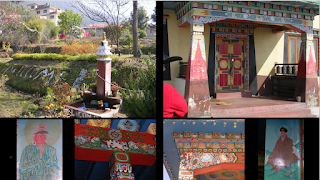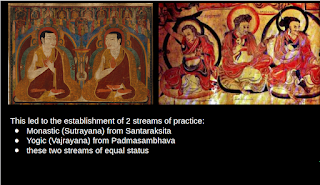The third reason for her pilgrimages was to 'address an historical prejudice'. Nor'dzin talked a little about the history of Buddhism in Tibet to introduce this topic. The 'first spread' of Buddhism occurred in the 8th century instigated by King Trisong Détsen. Two streams of Buddhism were established: Padmasambhava's Red Sangha (monastic community) and Shantarakshita's White Sangha (non-monastic, yogic community) and they were considered equal at that time. The Red Sangha are monks and nuns, wear red skirts and shave their heads as a symbol of renunciation. The White Sangha are non-monastic yogis and yoginis, wear white skirts and never cut their scalp hair as a symbol of embracing everyday life as practice.
Then about 100 years later a king suppressed Buddhist practices, destroying monasteries and persecuting practitioners. This led to practitioners retreating to the outer regions of the Tibetan Empire, which at that time included areas of Nepal, Bhutan and northern India. Buddhism returned to royal favour in the 11th century and two new schools were established, but with an emphasis on monasticism as the preferred style. This was the 'second spread' of Buddhism in Tibet. The original form of Buddhism became known as the 'Nyingma', meaning 'Ancient Ones'. The trend toward favouring monasticism was compounded in the 14th century with the creation of a new, entirely monastic school of Buddhism, and with both spiritual and political power and wealth becoming invested in this school. The White Sangha came to be regarded as disreputable and undesirable by those favouring the dominant monastic school, but nevertheless continued to the present day.







































